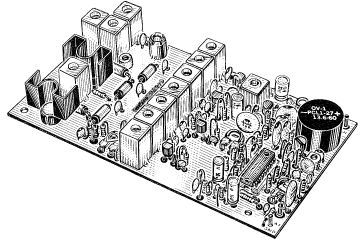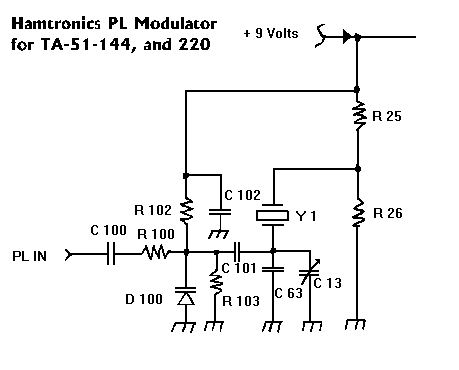
the Hamtronics TA-51
Hamtronics TA-51 Private Line Modulator
Concept:
Because the TA-51 exciter uses an RC phase modulator, this particular
one won't reproduce low frequencies well. It won't reproduce a PL tone at
deviations of more than 75 or 100 Hertz or so. Usually about 500 to 750
Hertz of deviation is desired, and the use of this add on modulator will
allow industry standard values of PL deviation with little to no audio
distortion.
This page deals with a modification to ham radio equipment, and is not FCC type accepted.

Description:
The circuit shown below is an add-on "true FM PL modulator" that
replaces C12, a 33pF disc cap, with a Varactor modulator in a
Hamtronics® TA-51 Exciter. Approximately 3 Volts P-P is needed
at the "PL IN" terminal to modulate the exciter to 500 Hertz deviation
on a 2 meter exciter. Up to 900 Hz. deviation is obtainable without
distortion. Normally, 500 to 750 Hz. PL deviation is recommended. A
Communications Specialists
TS-32 or SS-32 will
deviate the modulator from 0 to 900 Hz directly, the TS-64 will only
make 500 Hz. because of its reduced output. Slightly more deviation is
obtainable with the TA-51-220 because Q4 operates as a tripler and
therefore the crystal oscillator is multiplied more times. Less than 3
volts P-P is needed on a 220 MHz. exciter for 500 Hz. deviation. The
circuit is built dead bug style in the area around C13.
The frequency stability of this modification is excellent.
You will still use the original audio input for voice modulation as this new modulator is likely not linear across the entire voice range. Since a PL tone is only one frequency, linearity of this add on modulator is of no real concern.

Parts shown above with numbers of 100 or greater were added. R25, R26, Y1, C13, and C63 are original parts. Refer to your Hamtronics® schematic diagram, and the diagram above, to understand how to add the modulator components. The added resistors are carbon and not metal film to help decouple RF from other parts of the circuit.
NOTE: omit C12, a 33pF disc cap. or desolder and reuse as C101. Also C63 may have to be changed in value after installing PL modulator to properly net the crystal. The value of C63 in a 2 meter exciter usually ends up being 8pF with the trimmer centered. This allows about 5 kHz. of trimmer action each side of center.
If you have trouble obtaining the preferred 190 H 03 varactor diode, an MV 2101 can be substituted, however the value of C101 should be reduced (to about 15pF) and C63's value should be changed to net the crystal on frequency with the trimmer centered. The frequency stability due to temperature is not as good with an MV 2101. If you cannot get a varactor in your area you can use a 1N914 general purpose diode, however the maximum deviation will be limited because the 1N914's maximum junction capacitance is limited. Slightly reducing the value of R100 can help overcome this. 500 Hz. deviation is possible with a 1N914 in the above circuit, using the encoder part of the TS-32 (SS-32) turned all the way up. Using a 1N914 with a TS-64 is not recommended because you cannot get enough PL deviation due to its reduced output capability. Reducing the value of R100 a lot is not recommended because the value selected above decouples the RF energy produced by the crystal oscillator, and reducing its value will involve C100 and associated hookup wiring in the stability issue. If all else fails, I can supply the Motorola varactor diode; e-mail me and request further ordering information.
This circuit modification was designed by Kevin Custer W3KKC in June 1994.